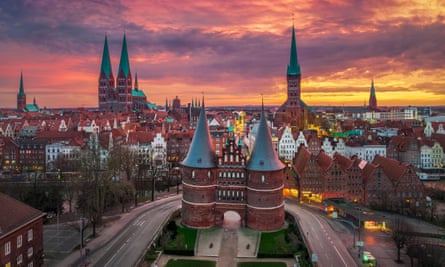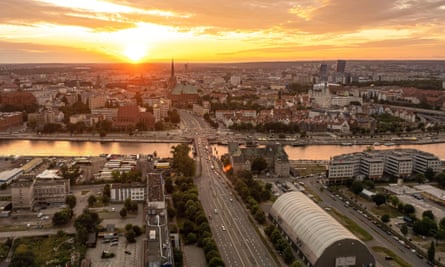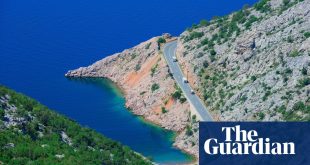The elegant main railway station in the Hanseatic city of Lübeck is well suited to grand departures, but these are few and far between these days. The only international destination served from Lübeck is Szczecin, in Poland. Half a dozen daily trains ply a meandering route through sparsely populated terrain on a 185-mile journey that starts in Holstein and then crosses Mecklenburg to reach Pomerania. It is a region where, historically, Prussia and Sweden vied for supremacy. Today it’s a chance to see off-the-beaten-track communities in a remote part of eastern Germany.
I start my journey by Lübeck’s celebrated Holstentor: it’s an extraordinary mid-15th-century city gate and sets the scene for the journey east towards Poland. The rail route from Lübeck to Szczecin is known as the Stadttore-Linie (the Town Gates Route). Several places along it boast fine examples of defensive gates, most of them in an architectural style found across the Baltic region. It’s called by the German name Backsteingotik (brick gothic).

Lübeck’s Holstentor is a good place to reflect on the remarkable wealth and influence Lübeck enjoyed in the Hanseatic era. Travellers who stop off along the Stadttore-Linie will find fine small towns that thrived on Hanseatic connections, many with striking brick-gothic gates, though none is as elaborate as the Lübeck example. There are fine Stadttore at Teterow, Malchin and Neubrandenburg. Curiously, the two prominent city gates in Szczecin, at the eastern end of the route, buck the brick-gothic trend in favour of neo-baroque style.
Hearing that the train to Szczecin is a no-frills affair, I stock up on marzipan, which is a Lübeck staple. From the Holstentor, it is just a five-minute walk to Platform 1 at Lübeck station where a modest two-carriage diesel train is ready to depart on its journey of almost five hours to Szczecin. It is initially very full, but quickly empties out. I suspect that no one on board is really travelling right through to Poland. “I’ve never travelled that far,” says the train’s guard. “In fact I’ve never been to Poland,” he adds as our train pirouettes around the west and south sides of Lübeck, slipping through the suburb of St Jürgen with fine views of Lübeck’s famous skyline away to the left. The medley of churches and distinctive redbrick warehouses has earned Lübeck a place on Unesco’s world heritage list as a showpieceof Hanseatic style.

Seven minutes into our journey, we cross an inconspicuous ditch which until October 1990 marked the border between the two German States. Yes, that wee ditch really was the line of the iron curtain. From here, until we enter Poland about 10 minutes before arriving in Szczecin, our journey on the slow train crosses the territory of the former German Democratic Republic.
Our route east shuns the coast, resolutely staying well inland. I stop off here and there, revisiting communities I knew from the early days after German reunification. We glide past lakes and forests, frequently catching glimpses of weathered farmsteads, empty storks’ nests and nervous deer.
I stay overnight in Güstrow, which is spick and span compared with 30 years ago, but this small town has lost 20% of its population since then (Hotel am Schlosspark has doubles from €99 with breakfast). It once had four town gates, but all are long gone. The attraction here is something different: a mysteriously beautiful sculpture by Ernst Barlach which floats just above head height in Güstrow’s imposing brick-gothic church. Barlach lived in Güstrow and the piece was created in 1927 as a memorial to those who perished in the first world war. With an admonishing look on her face, and features clearly resembling artist Käthe Kollwitz, the suspended angel speaks of a need for peace in a troubled world. It has a haunted look, and I am now keen to see the near-identical Barlach sculpture in Cologne.

The night in Güstrow is blissfully peaceful and early next morning I am back on the slow train heading east towards Poland. I pause for breakfast in Teterow, whose brick-gothic town gate is even older than Lübeck’s. Teterow is the western gateway to a mildly hilly area which styles itself as Mecklenburg’s answer to Switzerland. Believe me, there is nothing Swiss about the Mecklenburgische Schweiz, though it is undeniably beautiful.
As with so many rural regions of eastern Germany, this is an area with few visitors from afar, though, being only an hour or two from the German capital, it is much feted by Berliners for its rural charm and varied landscapes. Two women join the train in Malchin, and tell me I have missed a trick by not stopping off there.
after newsletter promotion

“One for the future,” I note adding Malchin to my growing list of small towns in eastern Germany which would surely repay a night or two. Now we are leaving the forests and entering agricultural country with far horizons. We cross the Ucker River in Pasewalk, and then bridge the Randow just before Löcknitz, where the spire of the village’s brick church points tall and proud into the Pomeranian sky.
Grambow is the last station in Germany, just after which we cross into Poland. The German-Polish border is by and large defined by rivers (the Oder and the Neisse) but as we approach Szczecin, there is an area of land on the west bank of the Oder which belongs to Poland. Within five minutes of crossing the frontier, our train is running through the suburbs of Szczecin, passing apartment blocks and retail parks on the final run into the city’s main station. It is an easy walk to Szczecin’s two surviving gates, both strangely isolated amid swirls of traffic.
Lübeck, I decide, has the edge when it comes to city gates. But the gates are merely the milestones on a rail journey which is a marvellous slow-travel diversion, one that reminded me of the exquisite beauty of a flatland region which deserves to be far better known.
Travel Facts
The train that runs from Lübeck to Szczecin is a local service and offers few creature comforts, even though the journey takes 4hr 53min. The Mecklenburg-Vorpommern Ticket (MVT) is great value at €22 for the entire route (and even back again). The ticket is valid for one day and stops are allowed, but with an overnight stop you need to buy a new MVT for the second day. Global Interrail passes are valid on the entire route.
Nicky Gardner is the author of Europe by Rail: the Definitive Guide, which can be ordered from the Guardian Bookshop
 Top Naija News: Nigerian News, Breaking News Nigeria and World News Top Naija News is a daily news publication in Nigeria, delivering the latest breaking news in Nigeria and around the world.
Top Naija News: Nigerian News, Breaking News Nigeria and World News Top Naija News is a daily news publication in Nigeria, delivering the latest breaking news in Nigeria and around the world.



